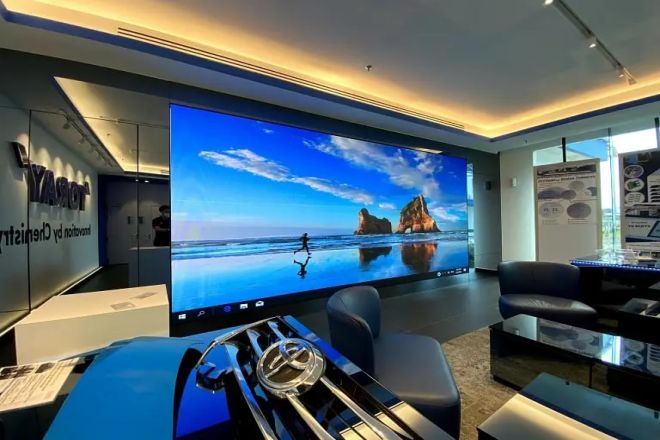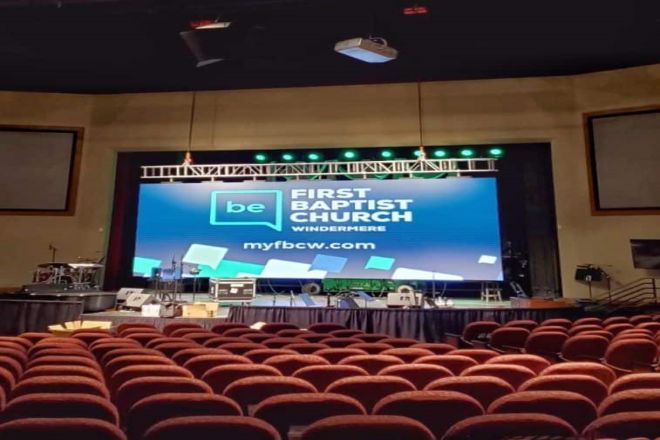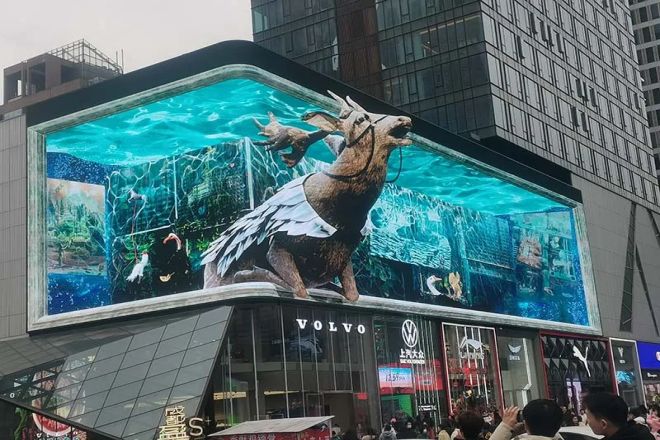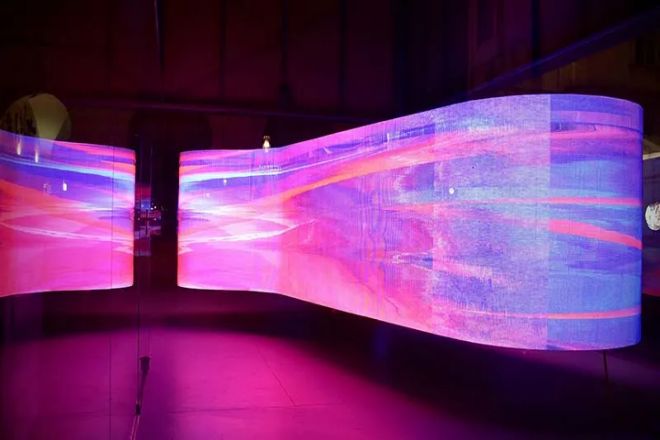Introduction

With the rapid development of science and technology, LED giant screen technology has gradually become an indispensable and important display tool for large-scale events, exhibitions, sports events, and other occasions due to its high-definition picture quality, bright colors, and high brightness.
This article will analyze the whole process of LED giant screen work in detail to help you understand the technical details and operation steps behind it.
1. Overview of the whole process of LED giant screen work
As an outstanding representative of modern audio-visual technology, the LED giant screen is widely used in various large-scale events, exhibitions, sports events, and other occasions. Its unique visual effects and shocking display capabilities have won wide acclaim.
However, the perfect presentation of a giant LED screen cannot be achieved overnight. It involves many complex and delicate steps. The work of an LED giant screen can be roughly divided into the following steps: preliminary preparation, design planning, production and installation, debugging and testing, on-site operation, and maintenance.
Each step is crucial, and they together ensure the perfect presentation of an LED giant screen.
2. Preliminary preparation

In the start-up stage of the LED giant screen project, preliminary preparation is a crucial link. The work at this stage not only lays the foundation for the subsequent design, production, and installation but also ensures that the project can proceed smoothly according to customer needs and expectations. The following is a detailed overview of the preliminary preparation work:
- Project Requirements Confirmation
At the beginning of the project, full communication with the customer is essential. The team needs to understand the customer’s specific requirements for the LED giant screen in detail, including key parameters such as size, resolution, brightness, color, etc. Through in-depth communication with the customer, it can ensure that both parties agree on the expectations and goals of the project, and provide clear guidance for subsequent design work.
When confirming the project requirements, the team also needs to consider some potential factors, such as the theme of the event, the venue environment, the size of the audience, etc. These factors will directly affect the design plan of the LED giant screen, so full discussion and consultation with the customer is required.
- Site Survey
Site survey is another important part of the preliminary preparation. The team needs to conduct a field survey of the installation site to understand the site environment, power supply, load-bearing structure, etc. Through the field survey, the team can obtain accurate site data to provide strong support for subsequent design and installation work.
During the survey, the team needs to pay special attention to the load-bearing capacity and power supply of the site. As a large-scale display device, the LED giant screen has high requirements for the load-bearing capacity and power supply of the site. Therefore, the team needs to ensure that the venue can meet the installation and operation requirements of the LED giant screen to avoid safety hazards or equipment damage.
- Budget formulation
The budget formulation is the last but equally important step in the preliminary preparation. The team needs to formulate a detailed budget plan based on customer needs and site conditions. The budget plan should include the costs of each link of the production, installation, commissioning, transportation, etc., of the LED giant screen, as well as possible additional costs and risks.
When formulating the budget plan, the team needs to fully consider the actual situation of the project and the economic situation of the customer. Through reasonable budget formulation, it can ensure that the project proceeds smoothly within the budget and avoid problems such as funding shortages or overspending. At the same time, the budget plan can also provide customers with a clear cost expectation and enhance customers’ trust and satisfaction with the project.
3. Design planning
In the process of the LED giant screen project, the design planning stage plays a vital role. This stage requires not only the team to deeply understand customer needs but also to fully consider the site conditions to ensure that the final design plan can meet the needs of the event and present the best visual effects. The following is a detailed overview of the design planning stage:
- Scheme design
Scheme design is the primary task of the design planning stage. The team needs to formulate an overall plan for the LED giant screen based on customer needs and site conditions. This includes determining key parameters such as screen size, resolution, and pixel density and selecting appropriate display technology and materials.
The determination of screen size needs to consider factors such as venue size, audience size, and visual effects. Resolution and pixel density directly affect the clarity and fineness of the picture and need to be weighed and adjusted according to the specific needs of the customer.
In addition, the selection of display technology and materials is also an important part of the scheme design, which will directly affect the display effect and service life of the LED giant screen.
- Structural design
Structural design is the key to ensuring the stability and safety of the LED giant screen. The team needs to design a suitable support structure based on the screen size and weight to withstand external factors such as the weight of the LED giant screen and wind force.
When designing the support structure, the team needs to consider the bearing capacity and installation conditions of the venue fully. At the same time, the structure needs to be carefully calculated and optimized to ensure its stability and safety. In addition, the team also needs to consider the detachability and mobility of the structure so that it can be quickly disassembled and transported when necessary.
- Video content production
Video content production is an indispensable part of the LED giant screen project. The team needs to produce video content that matches the LED giant screen based on customer needs and event themes.
When producing video content, the team needs to have an in-depth understanding of the theme and background of the event, as well as the information and emotions that the customer wants to convey. At the same time, the visual effects and expressiveness of the video content need to be considered to ensure the best visual experience on the LED giant screen.
In addition, the team also needs to consider factors such as the playback method and duration of the video content to ensure that it is coordinated with the overall rhythm and atmosphere of the event.
In summary, the design planning stage is a crucial link in the LED giant screen project. Through careful scheme design, structural design, and video content production, the team can present the best visual effects and perfect display experience to customers.
4. Production and installation

During the production and installation stage, the production and installation process of the LED giant screen needs to be strictly carried out in accordance with the design plan to ensure the quality and performance of the final product. The following are the detailed steps of this stage:
- Module production
Customize the LED module according to the design plan determined in the preliminary design planning stage. This includes determining the size, pixel density, brightness, and other parameters of the module to meet the project requirements.
In the module production process, advanced production processes and technologies need to be adopted to ensure the quality and performance of each module is optimal.
After the module is produced, strict quality inspection is carried out. This includes electrical performance testing, optical performance testing, mechanical performance testing, and other aspects to ensure that the quality of the module meets the design requirements.
- Module splicing
The manufactured LED modules are spliced according to the design plan. This includes determining the connection method and sequence between the modules to ensure that the size, resolution, and other aspects of the spliced LED giant screen are consistent with the design plan.
During the module splicing process, professional tools and equipment are required to ensure the accuracy and quality of the splicing. At the same time, it is also necessary to pay attention to protecting the surface of the module to avoid damage during the splicing process.
After the splicing is completed, the overall LED giant screen is preliminarily inspected and tested to ensure that the splicing quality meets the requirements.
- Installation and debugging
The spliced LED giant screen is installed in the predetermined position. This requires determining the appropriate installation method and position according to the actual situation of the site and the design plan.
During the installation process, it is necessary to ensure the stability and safety of the LED giant screen. This includes using appropriate support structures and fixing methods, as well as necessary reinforcement.
After the installation is completed, preliminary debugging and testing are carried out. This includes power supply testing, signal testing, brightness adjustment, color correction, and other aspects. Through debugging and testing, ensure that the LED giant screen can work normally and present the best visual effects.
5. Debugging and testing
After the LED giant screen is installed, the debugging and testing phase is the key link to ensure its normal operation and present the best effect. The following are the detailed steps of the debugging and testing phase:
- Brightness adjustment
Brightness is one of the important parameters of the LED giant screen, which directly affects the audience’s visual experience. The debugging personnel need to fine-tune the brightness of the LED giant screen according to the on-site environment and customer needs.
Brightness adjustment is usually achieved by controlling the current or pulse width of the LED lamp. Modern full-color LED display screens usually have automatic brightness adjustment functions, but in order to ensure the best display effect, manual adjustment is still a necessary step.
When adjusting the brightness, factors such as the brightness of the surrounding environment, the size of the LED giant screen, and the viewing distance of the audience should be taken into account. Generally speaking, too high brightness may produce a dazzling feeling, while too low brightness may affect the audience’s visual experience. Therefore, it is necessary to make detailed adjustments according to the actual situation.
Referring to the numerical range of brightness adjustment, it is usually a more reasonable range between 155-180, which can ensure that the LED large screen lamp current will not work at a high current for a long time, thereby extending its service life.
- Color calibration
Color calibration is an important step to ensure that the color of the LED giant screen is true and bright. Professional color correction instruments and software are required during the calibration process.
First, perform color space calibration to ensure that the color space of the display is consistent with the standard color space. Common color spaces include RGB color space and CMYK color space.
Second, color uniformity calibration is performed to ensure that the display’s color performance is consistent in different areas. This can be achieved by adjusting the brightness and color output of the LED lamp beads.
Finally, perform color temperature adjustment. Color temperature refers to the color characteristics of the light source. For LED giant screens, accurate color temperature adjustment can change the overall color tone of the display. Common color temperature adjustment methods include manual adjustment and automatic adjustment.
- Stability test
A stability test is a key step to ensure the long-term stable operation of the LED giant screen. During the test, the LED giant screen needs to run continuously for a period of time (such as several hours to several days) and observe whether it has any abnormal conditions.
During the test, attention should be paid to the changes in parameters such as brightness, color, and temperature of the display. If abnormal conditions occur, such as reduced brightness, color distortion, and rapid temperature increase, they should be checked and handled in time.
Stability tests can not only ensure that the LED giant screen can work properly before formal use but also discover potential faults and hidden dangers so as to repair and prevent them in advance.
6. On-site operation and maintenance

After the LED giant screen is successfully installed and passed the debugging test, it enters the on-site operation and maintenance stage to ensure its stability and reliability at the event site. The following are detailed steps for on-site operation and maintenance:
- On-site operation
According to the progress of the event and customer needs, carefully control the playback content and playback mode of the LED giant screen.
Use professional control software or system to ensure smooth playback and switching of content.
At the event site, arrange a dedicated person to be responsible for the operation and control of the LED giant screen to ensure synchronization with the progress of the event.
- Real-time monitoring
Monitor the LED giant screen in real-time and pay close attention to its operating status and picture quality.
Use modern monitoring technology and systems, such as cameras, sensors, etc., to achieve remote monitoring and real-time feedback.
Monitoring content includes but is not limited to key parameters such as brightness, color, temperature, and voltage to ensure that the LED giant screen operates in the best condition.
Establish an early warning mechanism. When the monitoring parameters exceed the normal range, issue an alarm in time and notify relevant personnel to handle it.
- Troubleshooting
When the LED giant screen fails, quickly locate and troubleshoot the fault to ensure the smooth progress of the event.
Common LED display screen failures include no response, abnormal display, low brightness, etc., and corresponding solutions should be adopted according to the specific situation.
For example, when the display screen is unresponsive, it may be due to a power outage or signal transmission problem. It is necessary to check whether the power connection and signal line are intact; when the display is abnormal, it may be due to display module failure, and the module needs to be replaced or repaired.
Equipped with professional maintenance teams and tools to ensure that faults can be handled promptly and effectively.
Establish fault handling records, record and analyze the causes, handling methods, and results of each fault, and provide reference and reference for subsequent maintenance.
Conclusion
The work of LED giant screen is a complex and delicate process, which requires close cooperation and strict control of all links. Through the analysis of this article, I believe that readers have a deeper understanding of the whole process of LED giant screen work. In the future, with the continuous advancement and innovation of technology, LED giant screen will play an important role in more fields and bring people a more colorful visual feast.
Finally, if you want to know more about LED display screens, please get in touch with us.
